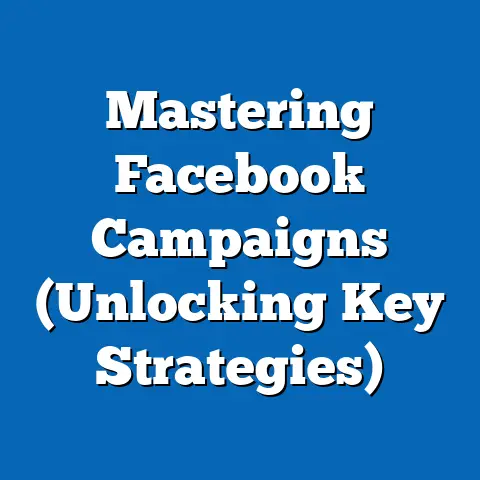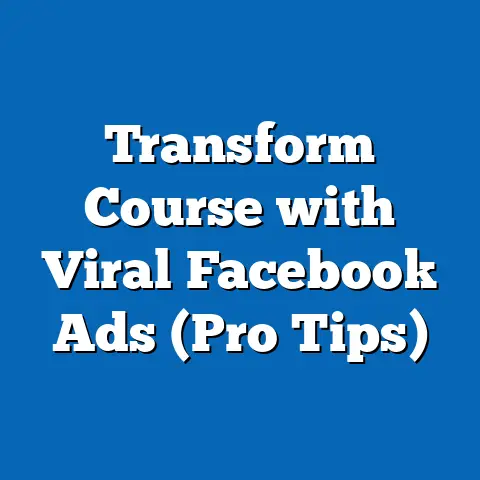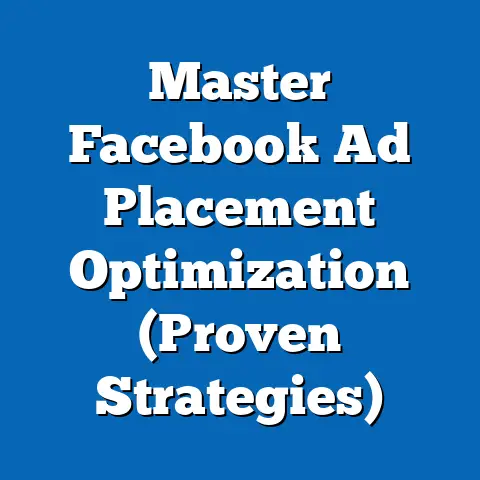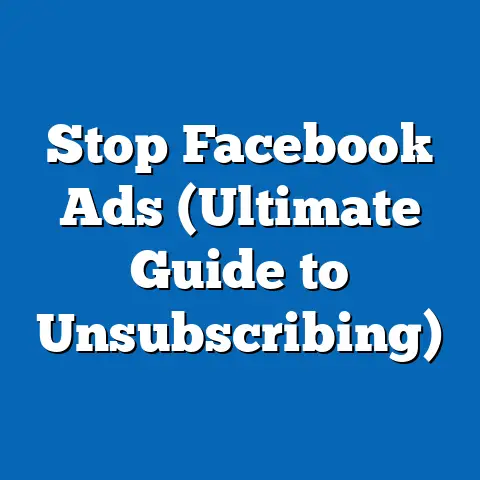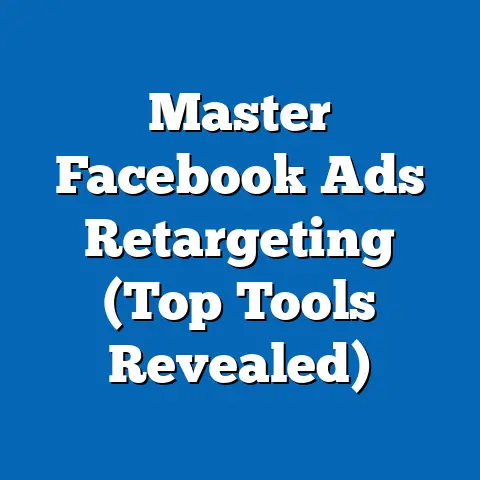Unlocking CPR in Facebook Ads (Essential Insights Revealed)
Imagine a moment of raw emotion: a parent, separated by distance from a child in need, frantically searching for a way to help during a medical emergency. In that desperate search, a Facebook ad appears—not just a promotion, but a lifeline, offering a quick tutorial on CPR (Cardiopulmonary Resuscitation). The emotional connection is immediate and profound; the ad transcends its commercial purpose, becoming a beacon of hope and empowerment in a moment of crisis.
In this comprehensive analysis, we will explore the concept of “unlocking CPR” in Facebook ads, delving into its emotional resonance, defining characteristics, historical context, and societal implications. We will examine how this innovative approach reflects generational values, technological advancements, and cultural shifts, while also considering its impact on public health awareness and digital marketing strategies. Through a data-driven lens, we aim to reveal essential insights into how such campaigns are shaping, and being shaped by, the diverse generations engaging with them.
Defining Characteristics of CPR in Facebook Ads
At its core, the concept of integrating CPR education into Facebook ads is characterized by its dual purpose: raising awareness about a critical life-saving skill while leveraging the emotional and viral potential of social media. These ads often feature compelling visuals—such as a dramatic reenactment of an emergency or a heartfelt testimonial from someone saved by CPR—paired with concise, actionable instructions or links to further resources.
Unlike traditional public service announcements, these ads are tailored to the fast-paced, scroll-heavy nature of social media. They are designed to grab attention within seconds, often using emotionally charged narratives to encourage sharing and engagement. Additionally, they utilize Facebook’s sophisticated targeting algorithms to reach specific demographics, such as parents, caregivers, or individuals in high-risk communities, ensuring relevance and impact.
Another defining feature is the collaborative nature of these campaigns. Many are developed in partnership with health organizations, such as the American Heart Association, combining medical expertise with digital marketing savvy. This hybrid approach enhances credibility while amplifying reach through social sharing—a phenomenon particularly resonant with younger, tech-savvy generations like Millennials and Gen Z.
Historical Context: From Public Health Campaigns to Digital Innovation
To understand the significance of CPR education in Facebook ads, we must first consider the historical evolution of public health messaging and digital advertising. CPR as a life-saving technique gained widespread recognition in the 1960s, following the development of modern methods by medical researchers like Dr. James Jude and Dr. Peter Safar. Public health campaigns in the subsequent decades relied heavily on television, radio, and print media to educate the masses, often with limited reach and engagement.
The advent of the internet in the late 1990s and early 2000s marked a turning point, as health organizations began using websites and email campaigns to disseminate information. However, it was the rise of social media platforms like Facebook, launched in 2004, that truly revolutionized how public health messages could be delivered. With billions of users worldwide, Facebook offered unprecedented access to diverse audiences, enabling hyper-targeted and interactive content.
The integration of CPR education into ads aligns with broader historical shifts in marketing, where brands and organizations increasingly prioritize social impact alongside profit. This trend gained momentum during the 2010s, a period marked by global crises like the 2008 financial recession and the COVID-19 pandemic, which heightened public demand for meaningful, value-driven content. For generations like Millennials (born 1981–1996) and Gen Z (born 1997–2012), who grew up amid these challenges, authenticity and social responsibility in advertising are not just preferences but expectations.
Societal Implications: Bridging Generational Divides Through Digital Advocacy
The societal implications of CPR-focused Facebook ads are multifaceted, touching on public health, digital literacy, and intergenerational dynamics. At the most immediate level, these ads contribute to greater awareness and accessibility of CPR training, a critical public health issue. According to the American Heart Association, nearly 90% of cardiac arrests occur outside of hospitals, and effective bystander CPR can double or triple a victim’s chance of survival. By embedding education into everyday digital experiences, these ads lower barriers to learning, potentially saving countless lives.
From a generational perspective, the approach resonates differently across age groups, reflecting distinct values and technological comfort levels. For Baby Boomers (born 1946–1964), who may have limited exposure to social media, such ads can serve as an introduction to digital health resources, though their engagement may be lower due to privacy concerns or unfamiliarity with the platform. In contrast, Millennials and Gen Z, who are digital natives, are more likely to interact with and share these ads, driven by a desire to contribute to communal good and a fluency with viral content.
Gen X (born 1965–1980), often caught between traditional and digital worlds, may appreciate the practical utility of these ads while remaining skeptical of their motives, given their historical exposure to overt commercialism in advertising. This generational diversity underscores the need for tailored messaging—ensuring that emotional narratives and calls to action resonate with varying life experiences and media consumption habits.
Beyond individual impact, these campaigns reflect a broader cultural shift toward collective responsibility in the digital age. They challenge the notion of social media as a purely commercial or entertainment-driven space, instead positioning it as a platform for advocacy and education. This aligns with the values of younger generations, who often prioritize purpose over profit, but it also raises questions about the role of corporations in public health and the potential for “cause marketing” to blur ethical lines.
Technological Factors: The Power of Algorithms and Engagement
The success of CPR education in Facebook ads is deeply tied to technological advancements, particularly the platform’s targeting and analytics capabilities. Facebook’s algorithm allows advertisers to segment audiences based on demographics, interests, and behaviors, ensuring that CPR ads reach those most likely to benefit—such as parents of young children or individuals in areas with high rates of cardiac incidents. This precision targeting maximizes impact, a stark contrast to the broad, less measurable reach of traditional media.
Moreover, the interactive nature of social media amplifies engagement. Features like comments, shares, and reactions enable users to spread the message organically, creating a ripple effect that traditional ads rarely achieve. Data from Meta (Facebook’s parent company) indicates that video ads, often used in CPR campaigns, see engagement rates up to 6% higher than static posts, highlighting the power of dynamic storytelling in this context.
However, technology also presents challenges. Algorithmic bias can inadvertently exclude certain groups from seeing these ads, while privacy concerns may deter users from clicking on health-related content. Additionally, the fleeting nature of social media content means that sustained education—beyond a single ad—requires strategic follow-up, such as links to certified training programs or reminder campaigns.
Economic and Social Influences: Balancing Profit and Purpose
Economically, the integration of CPR education into Facebook ads reflects a growing trend of corporate social responsibility (CSR) in marketing. Brands and health organizations investing in these campaigns often do so with dual motives: enhancing public good while building brand loyalty. For instance, a company sponsoring a CPR ad may gain positive publicity, particularly among socially conscious consumers like Millennials, who, according to a 2019 Nielsen report, are 60% more likely to support brands with a clear social mission.
Socially, these ads tap into a collective desire for empowerment and preparedness, themes that resonate across generations but manifest differently. For older generations like Baby Boomers, the focus may be on personal safety and protecting loved ones, shaped by historical experiences of limited medical access in earlier decades. Younger generations, conversely, often frame these issues through a lens of community impact, influenced by social movements and a hyper-connected world.
Yet, there are nuances to consider. Not all communities have equal access to the digital spaces where these ads appear. Rural areas or low-income populations with limited internet access may miss out, perpetuating health disparities. Additionally, cultural differences in how emergencies are perceived or addressed can affect the reception of these messages, highlighting the need for localized and inclusive content.
Cultural Shifts: Redefining Advertising in the Digital Age
Culturally, CPR-focused Facebook ads signal a redefinition of advertising as a tool for education and advocacy. This shift is particularly pronounced in the context of generational attitudes toward media. Baby Boomers and Gen X, raised on traditional advertising, may initially view these ads with skepticism, accustomed to separating commercial content from public service messages. However, the emotional storytelling often employed can bridge this gap, appealing to universal human experiences like loss or the instinct to protect.
For Millennials and Gen Z, who have grown up with integrated digital experiences, the blending of education and advertising feels natural. These generations value authenticity and are more likely to engage with content that aligns with their values, as evidenced by a 2021 Pew Research study showing that 70% of Gen Z users follow brands or causes they believe in on social media. This cultural alignment makes CPR ads particularly effective among younger audiences, though it also raises expectations for transparency and genuine impact.
Generational Comparisons: Diverse Responses and Shared Goals
Comparing generational responses to CPR in Facebook ads reveals both differences and commonalities. Baby Boomers may prioritize the practical information in these ads, seeking clear instructions over emotional narratives, while Gen X often balances practicality with a critical eye toward intent, shaped by their exposure to both traditional and digital media landscapes. Millennials, known for their social consciousness, are likely to share and advocate for these ads, seeing them as part of a broader movement for societal good.
Gen Z, meanwhile, brings a unique perspective, often engaging with content through a lens of immediacy and visual impact. Their preference for short-form, high-energy content (think TikTok-style videos) means CPR ads must adapt to maintain relevance, perhaps incorporating gamification or influencer partnerships. Despite these differences, all generations share a fundamental desire for safety and empowerment, a unifying thread that underscores the universal appeal of life-saving education.
It’s critical to avoid oversimplification here. Within each generation, factors like socioeconomic status, cultural background, and personal experience shape how individuals interact with these ads. A one-size-fits-all approach risks alienating segments of the population, emphasizing the importance of nuanced, data-informed strategies.
Implications for Society, Culture, and the Workplace
The broader implications of CPR education in Facebook ads extend to multiple domains. Societally, these campaigns contribute to a more informed public, potentially reducing mortality rates from cardiac arrests and fostering a culture of preparedness. They also highlight the role of technology in public health, setting a precedent for future digital interventions on issues like mental health or disaster response.
Culturally, they challenge traditional boundaries between advertising and advocacy, encouraging a reevaluation of how media can serve the public good. This is particularly relevant in an era of misinformation, where credible, emotionally resonant content can counteract harmful narratives. For younger generations, this reinforces trust in digital platforms as sources of valuable information, though it also necessitates media literacy to discern genuine efforts from performative marketing.
In the workplace, the focus on CPR education aligns with growing emphasis on employee well-being and safety training. Companies partnering on these ads may see benefits in brand perception among employees, particularly Millennials and Gen Z, who prioritize working for socially responsible organizations. Moreover, the skills promoted in these ads can translate to safer work environments, a concern shared across generations.
Forward-Looking Insights: Opportunities and Uncertainties
Looking ahead, the integration of CPR education into Facebook ads holds immense potential but also faces uncertainties. Advances in technology, such as augmented reality (AR) tutorials or AI-driven personalization, could enhance the effectiveness of these campaigns, offering immersive learning experiences tailored to individual needs. Partnerships with influencers or community leaders could further amplify reach, particularly among younger or underserved populations.
However, challenges remain. Regulatory scrutiny over data privacy on platforms like Facebook may limit targeting capabilities, while the risk of ad fatigue could diminish engagement over time. Additionally, ensuring equitable access across generations and demographics will require innovative solutions, such as offline extensions of digital campaigns or multilingual content.
The generational landscape itself is evolving, with the rise of Generation Alpha (born 2013–present) introducing new dynamics. As digital natives from birth, their expectations for seamless, impactful content will likely push the boundaries of what CPR ads can achieve. Yet, predicting exact outcomes is complex, given the rapid pace of technological and cultural change.
Conclusion: A Lifeline in the Digital Age
Unlocking CPR in Facebook ads represents more than a marketing trend; it is a powerful example of how technology, emotion, and societal need can converge to create meaningful impact. By blending education with engagement, these campaigns resonate across generations, reflecting shared values of safety and empowerment while adapting to diverse technological and cultural contexts.
As we move forward, the challenge lies in sustaining this momentum—ensuring that such initiatives remain authentic, accessible, and inclusive. While uncertainties persist, the potential for digital platforms to serve as lifelines in moments of crisis offers a hopeful vision for the future of public health advocacy. Through continued research and collaboration, we can unlock even deeper insights, harnessing the power of connection to save lives, one click at a time.

